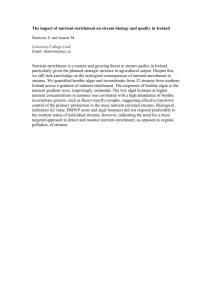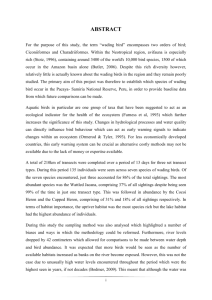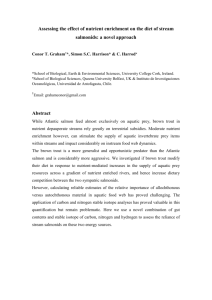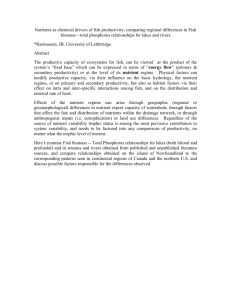Avian Response to Nutrient Enrichment in the Northern Everglades
advertisement
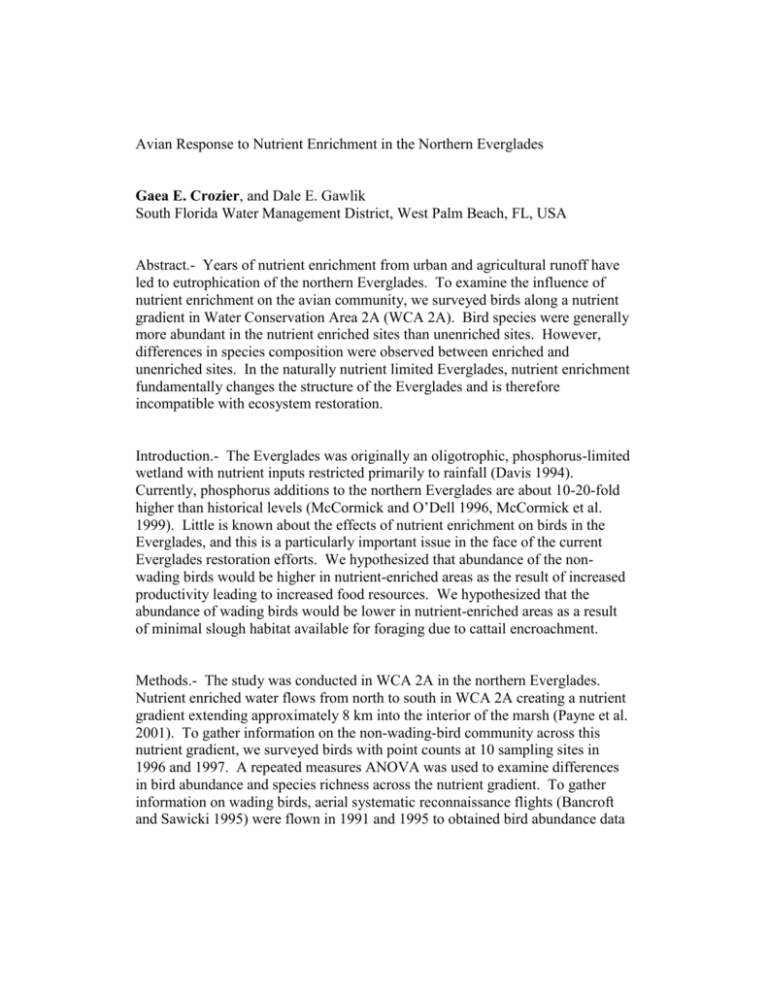
Avian Response to Nutrient Enrichment in the Northern Everglades Gaea E. Crozier, and Dale E. Gawlik South Florida Water Management District, West Palm Beach, FL, USA Abstract.- Years of nutrient enrichment from urban and agricultural runoff have led to eutrophication of the northern Everglades. To examine the influence of nutrient enrichment on the avian community, we surveyed birds along a nutrient gradient in Water Conservation Area 2A (WCA 2A). Bird species were generally more abundant in the nutrient enriched sites than unenriched sites. However, differences in species composition were observed between enriched and unenriched sites. In the naturally nutrient limited Everglades, nutrient enrichment fundamentally changes the structure of the Everglades and is therefore incompatible with ecosystem restoration. Introduction.- The Everglades was originally an oligotrophic, phosphorus-limited wetland with nutrient inputs restricted primarily to rainfall (Davis 1994). Currently, phosphorus additions to the northern Everglades are about 10-20-fold higher than historical levels (McCormick and O’Dell 1996, McCormick et al. 1999). Little is known about the effects of nutrient enrichment on birds in the Everglades, and this is a particularly important issue in the face of the current Everglades restoration efforts. We hypothesized that abundance of the nonwading birds would be higher in nutrient-enriched areas as the result of increased productivity leading to increased food resources. We hypothesized that the abundance of wading birds would be lower in nutrient-enriched areas as a result of minimal slough habitat available for foraging due to cattail encroachment. Methods.- The study was conducted in WCA 2A in the northern Everglades. Nutrient enriched water flows from north to south in WCA 2A creating a nutrient gradient extending approximately 8 km into the interior of the marsh (Payne et al. 2001). To gather information on the non-wading-bird community across this nutrient gradient, we surveyed birds with point counts at 10 sampling sites in 1996 and 1997. A repeated measures ANOVA was used to examine differences in bird abundance and species richness across the nutrient gradient. To gather information on wading birds, aerial systematic reconnaissance flights (Bancroft and Sawicki 1995) were flown in 1991 and 1995 to obtained bird abundance data in 4-km2 cells across WCA 2A. An ANCOVA with water depth as a covariate was used to compare wading-bird abundance in enriched and unenriched cells. Results.- There were more individuals (all species combined) in enriched sites compared to transitional and unenriched along the nutrient gradient (P = 0.05; Fig. 1). There was not a significant effect of nutrient enrichment on species richness. Of the four dominant species in the study, Boat-tailed Grackles and Common Moorhens were more abundant in enriched sites (P 0.02) while Common Yellowthroats were more abundant in unenriched sites (P < 0.01). Redwinged Blackbirds showed no effect. Examining species compositional differences, the bird community in enriched areas tended to have more species that prefer densely vegetated areas (i.e., rails, bitterns) whereas unenriched areas had more species that utilize open areas (i.e., shorebirds). In the wading bird community, Wood Storks and Great Egrets were more abundant (P < 0.01) in the enriched compared to unenriched 4-km2 cells in a dry year (Fig. 2). Great Egrets and all wading bird species combined had significantly more individuals (P < 0.01) in the enriched compared to the unenriched cells in a wet year. For White Ibises and Wood Storks, the models did not converge in the wet year, however, there tended to be more individuals in enriched compared to unenriched cells. Discussion.- The results of this study suggest that some members of the bird community tend to increase in abundance with nutrient enrichment. Changes in habitat (i.e., increased amount of substrate for nesting or foraging) or changes in the food web that increased food resources were presumably the cause. Overall, water depth was the main factor affecting wading bird foraging. After accounting for water depth, wading bird abundance generally increased in nutrient-enriched areas even though cattail invasion left few open-water sloughs for foraging. We suspect this was because the few open-water areas available to wading birds had a higher availability of prey. However, the majority of open-water sites in enriched areas in our study had been artificially created by airboat traffic. We hypothesize that in dry years the abundance of wading birds is primarily driven by decreasing water levels concentrating prey, but in wet years wading bird abundance is also driven by habitat characteristics, such as nutrient enrichment, that may make prey more available. Although bird abundance may generally increase in nutrientenriched areas of the Everglades, this is undesirable when indicative of an unhealthy ecosystem. Nutrient enrichment fundamentally changes the Everglades by changing the species composition and productivity of different components of the system. Fig. 1. The mean ± SE number of birds per site in enriched (n = 4; solid black), transitional (n = 4; striped white), and unenriched (n = 2; solid white) areas. Fig. 2. The mean ± SE number of four common wading bird species and all wading species combined in enriched (n = 22 in 1991, n = 108 in 1995; solid black) and unenriched (n = 128 in 1991, n = 342 in 1995; striped white) cells. Gaea Crozier, South Florida Water Management District, Everglades Division MS 4840, 3301 Gun Club Rd., West Palm Beach, FL 33406, Phone: 561-6868800 Ext. 4538, Fax: 561-682-6442, gcrozie@sfwmd.gov

